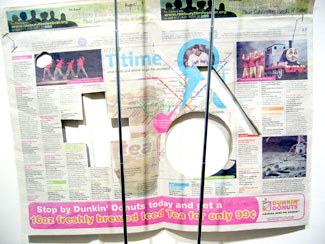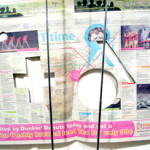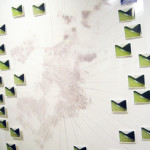By FRANK PEREZ
Having just read an article on a graffiti artist becoming legitimized by selling a spray painted portrait in a gallery for tens of thousands, in my mind, when I saw the ad for the Stencils, I had imagined the gallery walls littered with swatches of patterned, spray painted graphics. Because of this, I showed up at the gallery thinking the exhibit was over. Interestingly enough, there were patterns, just not the overt urban graphics I had expected. The patterns are there, though they exist in the compression of information that exist on such an extended scale of time or physical space, they often go unnoticed.
Stencils: Public Space and Social Intervention, guest curated by Alice Vogler and Hiroko Kikuchi, features artists Dirk Adams, Beth Balliro, Michael Gardiner, Geoff Hargadon, Lazaro Montano, Lucas Murgida, Liz Nofziger, Melina O’Grady & Niko, Vela Phelan, Paul Roux, Claudia Salamanca, Jonathan Santos, Andi Sutton. Each artist was invited to propose a project based on open interpretation of “stencil” as a concept, creating a forum for not only defining what a stencil is, but how a stencil creates meaning. Stenciling then becomes a matrix by which information is filtered - revealing information and obscuring it at the same time.
Few of us actually can register the physical manifestations of such filtered information which is why there are novelty maps or city guides to try to contextualize meaning of place on a human scale, transforming space into place. To extend that notion, a Google map is one kind of stencil, filtering out some information in favor of others, it offers a few alternatives – Traffic, Map, Satellite, and Hybrid – to construct as whole a view as possible. The interactive display of Google Earth is more of a fantasy of technology than useful information for most, given that many people only look for Easter egg anomalies or the top of their house.
Whether physically or metaphorically, each artist uses their criteria and interpretation of stenciling (as the exhibition statement reads), “to spark discussion about art and its purpose as a tool for social commentary.” While some artists chose a literal stencil, like with Geoff Hargadon, who created a framing device to where pedestrians can trace passing shadows in chalk, or Lazaro Montano, creates repeated textual messages that appear in various locations of the South End which become coded signposts, or Liz Nofziger, interrupting a full view of a TV by a cutout overlay.
Others use memory and personal geography, like Jonathan Santos, mapping out statistical sites of past violent crimes, or Dirk Adams, who created a guided audio tour of the South End, reevaluating the convention of a guided tour by describing a place though a firsthand and personalized history of overlooked “points of interest”. Another act of stencilling as a kind myopic cultural stamp is Melina O'Grady (and her daughter, Niko), by deconstructing cultural stamps underlying manufactured baby clothing with “cute” phrases as stereotypically gendered phrases and colors denoting male or female orientation.
Whether or not this show pushes the, "boundaries of how the public experiences and interacts with art”, as the exhibition statement statement suggests, is unclear since what appears in the gallery are merely gestures to alter these public perceptions, leaving gaps of confusion or curiosity, at best. To comprehend it more, I would have had to participate outside the gallery walls in one of these organized interactions, which begs the question whether or not these acts of stenciling are public enough. Perhaps this isn't necessary, public sapce is so large and many of these pieces require individualized experience. Maybe, if by seeing this exhibit, I can participate in the goal of this exhibit by finding my own filter for information in my own environment - finding a new way home instead of just following the MBTA perscription to a terminal station.
The gallery is not so much a venue for the performances, as a it is a home venue to show the planning, the remnants, and artifacts from such interactions throughout the city. These small interruptions, while temporary and sometimes unnoticed, if recognized, help present how information streams through us, making us more aware of our surroundings, giving us a new presentation of systems for information.
- Liz Nofziger, Media-edit (T.V. cozy), cut paper, 2007
- Jonathan Santos, 1-1=1, photographs and map on transparency, 2007
- Melina O’Grady and daughter Niko, Blink, children’s clothing, 2007
Stencils: Exhibit Information
New England School of Art and Design
"Stencils: Public Space and Social Intervention" is on view until August 26 at The New England School of Art & Design at Suffolk University, located at 75 Arlington St., Boston.
All images are courtesy of the artists and NESAD Gallery.







